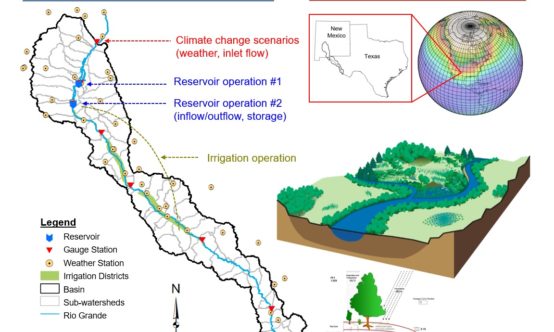Helping West Texas thrive by conducting innovative research to ensure the continued availability of high-quality water, soil, and food.
 The Texas A&M AgriLife Research Center at El Paso strives to address problems arising from El Paso’s unique geography. The city is situated on the U.S.-Mexico border and is home to 950,000 people — 96 percent of the population of Far West Texas. Across the Rio Grande is the neighboring Ciudad Juárez, Mexico, with a population of 1.3 million. The region’s frequent droughts and rapidly growing population underscore an urgent need for sufficient, reliable, safe, and cost-efficient water, soil, and food supplies. Focusing on the most pressing needs of Far West Texas, the Texas A&M AgriLife Research Center at El Paso is home to internationally recognized research programs in controlled environment agriculture, the development of profitable drought and salt-tolerant crops, freshwater conservation, groundwater and surface water management, hydrological system dynamics and resilience, natural resource economics and policy, public health nutrition, and salinity management.
The Texas A&M AgriLife Research Center at El Paso strives to address problems arising from El Paso’s unique geography. The city is situated on the U.S.-Mexico border and is home to 950,000 people — 96 percent of the population of Far West Texas. Across the Rio Grande is the neighboring Ciudad Juárez, Mexico, with a population of 1.3 million. The region’s frequent droughts and rapidly growing population underscore an urgent need for sufficient, reliable, safe, and cost-efficient water, soil, and food supplies. Focusing on the most pressing needs of Far West Texas, the Texas A&M AgriLife Research Center at El Paso is home to internationally recognized research programs in controlled environment agriculture, the development of profitable drought and salt-tolerant crops, freshwater conservation, groundwater and surface water management, hydrological system dynamics and resilience, natural resource economics and policy, public health nutrition, and salinity management.
Arid Hydrology and Water Systems

The Arid Hydrology and Water Systems research program focuses on hydrology in arid regions, and transboundary water resources planning and management.
Public Health Nutrition

The Public Health Nutrition program studies healthy eating behavior, food access, and the relationship between dietary intake and health.
Water Resources and Salinity Management

The Water Resources and Salinity Management research program specializes in salinity assessment and management, beneficial use of waters with elevated salinity such as industrial wastewater, gray-water, reclaimed water, brackish groundwater, and on-farm water conservation.
